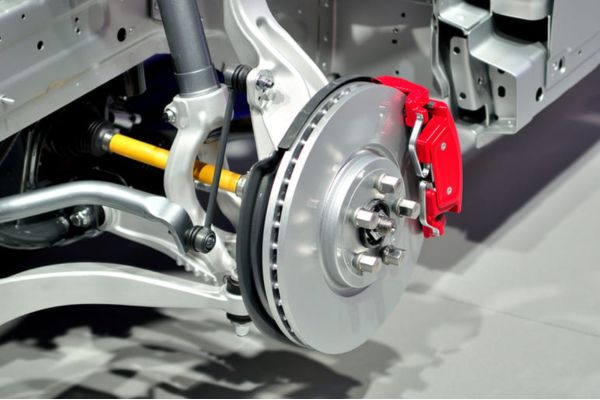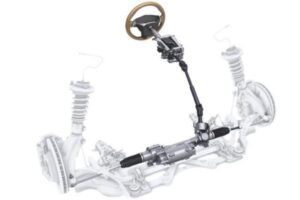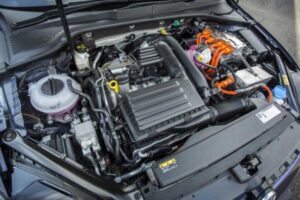The braking system is a critical component of any vehicle, ensuring safe and reliable deceleration and stopping. In this article, we will delve into the intricate components that constitute a vehicle’s braking system, including discs, pads, drums, shoes, and master cylinders.
Components of the Braking System: Understanding its Complexity
The braking system of a vehicle is a complex assembly of various components working together harmoniously to achieve efficient braking performance. Let’s explore each of these components in detail:
- Disc Brakes: Disc brakes consist of a rotor (disc) attached to the wheel hub and a caliper that houses the brake pads. When the brake pedal is pressed, hydraulic pressure forces the caliper pistons to squeeze the brake pads against the rotating disc, creating friction that slows down the vehicle.
- Brake Pads: Brake pads are friction materials designed to withstand high temperatures and pressure. They are essential for generating the necessary friction against the disc to convert kinetic energy into heat and bring the vehicle to a stop.
- Drum Brakes: Drum brakes are commonly used in the rear wheels of some vehicles. They consist of a brake drum attached to the wheel and brake shoes inside the drum. When the brake pedal is applied, the brake shoes are forced outward against the drum’s inner surface, generating friction and decelerating the vehicle.
- Brake Shoes: Brake shoes are curved metal components lined with friction material. When the brake pedal is pressed, the brake shoes are pressed against the drum’s inner surface to create friction, aiding in the braking process.
- Master Cylinder: The master cylinder is the heart of the hydraulic braking system. When the brake pedal is depressed, it generates hydraulic pressure that is transmitted through brake lines to actuate the calipers (in disc brakes) or the wheel cylinders (in drum brakes).
Understanding the roles and interactions of these components is crucial for comprehending the complexity of a vehicle’s braking system.
Disc Brakes vs. Drum Brakes: Comparing the Technologies
Braking systems in modern vehicles mainly employ either disc brakes or drum brakes, each with its unique characteristics and applications. Let’s compare these two technologies:
Disc Brakes
Advantages:
- Efficient heat dissipation, reducing the risk of brake fade.
- Better performance in wet conditions due to improved water dispersion.
- Easier maintenance and faster pad replacement.
- More commonly used in front-wheel-drive vehicles and high-performance cars.
Disadvantages:
- Generally more expensive to manufacture and repair.
- Prone to warping or uneven wear on the rotor under extreme conditions.
Drum Brakes
Advantages:
- Simpler design, making them cost-effective.
- Self-adjusting mechanism for brake shoes.
- Effective parking brake function due to its internal design.
Disadvantages:
- More susceptible to heat buildup, leading to brake fade.
- Reduced performance in wet conditions due to water retention in the drum.
- Longer braking distances compared to disc brakes.
The choice between disc brakes and drum brakes depends on the vehicle’s intended use, cost considerations, and braking performance requirements.
Hydraulic Braking System: How Pressure is Transmitted
The hydraulic braking system plays a crucial role in translating the force applied to the brake pedal into the pressure required to engage the brakes. Here’s how the hydraulic system works:
- Brake Pedal: When the driver presses the brake pedal, a plunger inside the master cylinder is actuated.
- Master Cylinder: The master cylinder is connected to the brake pedal and houses a reservoir of brake fluid. As the plunger in the master cylinder is pushed, it pressurizes the brake fluid.
- Brake Lines: The pressurized brake fluid is transmitted through brake lines to the brake calipers (or wheel cylinders in drum brakes).
- Calipers/Wheel Cylinders: In disc brakes, the pressurized brake fluid forces the caliper pistons to squeeze the brake pads against the disc. In drum brakes, the fluid pushes the wheel cylinders outward, pressing the brake shoes against the drum.
- Friction and Braking: The friction generated between the brake pads (or shoes) and the rotating disc (or drum) converts kinetic energy into heat, resulting in the deceleration of the vehicle.
The hydraulic braking system is a crucial aspect of modern vehicles, providing precise and reliable control over the braking process.
ABS – Anti-Lock Braking System: The Life-Saving Technology
The Anti-Lock Braking System (ABS) is an integral safety feature in modern vehicles, designed to prevent wheel lock-up during sudden or hard braking. The ABS employs sophisticated sensors, hydraulic valves, and a control unit to modulate brake pressure rapidly, allowing the driver to maintain steering control and stability during emergency braking.
The key benefits of ABS include:
- Preventing Skidding: By preventing the wheels from locking up, ABS allows the vehicle to maintain traction with the road surface, reducing the risk of skidding and loss of control.
- Enhanced Stability: ABS minimizes lateral skidding during hard braking, enabling the driver to maneuver and steer the vehicle more effectively.
- Shorter Braking Distances: ABS optimizes braking force, resulting in shorter stopping distances on most road surfaces.
- Safety in Adverse Conditions: ABS is particularly valuable in adverse weather conditions, such as rain, snow, or ice, where maintaining traction is challenging.
It’s crucial to note that ABS enhances, rather than replaces, the importance of safe driving practices and maintaining a well-functioning braking system.
Preventive Maintenance of the Braking System: Ensuring Safe Driving
Regular maintenance of the braking system is vital to ensure the safety and performance of a vehicle. Here are some essential tips for preventive maintenance:
- Brake Fluid Inspection: Check the brake fluid level and condition regularly. If the fluid is discolored or contains air bubbles, it may be time for a fluid exchange.
- Brake Pad Inspection: Regularly inspect the brake pads for wear and thickness. Replace them if they are worn close to the minimum thickness specified by the vehicle manufacturer.
- Rotor and Drum Inspection: Check the brake rotors and drums for signs of wear, scoring, or warping. Resurface or replace them as needed to maintain optimal braking performance.
- Brake Lines and Hoses: Inspect brake lines and hoses for any signs of leaks, damage, or corrosion. Replace any compromised components to prevent brake fluid leakage.
- Brake System Flushing: Periodically flush the entire brake system to remove any contaminants or moisture that may compromise braking efficiency.
- Parking Brake Maintenance: Ensure the parking brake functions correctly and adjust it as necessary to prevent unintentional vehicle movement when parked.
By adhering to these maintenance practices, drivers can uphold the integrity of their vehicle’s braking system and enjoy safe and trouble-free driving experiences.
Recognizing Brake System Issues: Identifying Malfunctions and Wear
A well-maintained braking system should operate quietly and effectively. However, over time, wear and tear may result in performance issues. Here are some common signs of brake system problems:
- Squealing or Grinding Noises: Unusual noises when braking may indicate worn-out brake pads or the presence of debris between the pads and rotors.
- Brake Fluid Leaks: Puddles of brake fluid under the vehicle may signal a leak in the brake system, which requires immediate attention.
- Soft or Spongy Brake Pedal: A soft or spongy brake pedal may indicate air in the brake lines or a problem with the master cylinder.
- Vibrations or Pulsations: Vibrations or pulsations felt through the brake pedal or steering wheel during braking may suggest warped brake rotors.
- ABS Warning Light: The ABS warning light illuminating on the dashboard indicates a potential issue with the ABS system and requires professional diagnosis.
If any of these symptoms are present, it is advisable to have the vehicle inspected by a qualified mechanic to identify and resolve the underlying brake system issues.
Upgrades in the Braking System: Enhancing Performance
For automotive enthusiasts and drivers seeking enhanced braking performance, various upgrades are available to optimize the braking system:
- High-Performance Brake Pads: Upgrading to high-performance brake pads with advanced friction materials can provide improved stopping power and fade resistance.
- Performance Brake Rotors: Performance brake rotors, such as drilled or slotted rotors, offer enhanced heat dissipation and reduced brake fade.
- Stainless Steel Brake Lines: Replacing the standard rubber brake lines with stainless steel braided lines reduces expansion, providing a firmer brake pedal feel.
- Brake Caliper Upgrades: Performance brake calipers with larger pistons and improved materials can enhance brake modulation and responsiveness.
- Upgraded Brake Fluid: High-performance brake fluid with a higher boiling point can withstand extreme temperatures and reduce the risk of brake fade.
It is essential to choose upgrades that are compatible with the vehicle’s braking system and intended use. Professional guidance and installation are recommended to ensure optimal results and safety.
Conclusion
The braking system is an integral aspect of vehicle safety and performance. Understanding the components and technologies involved in a braking system allows drivers to appreciate the complexity of this essential automotive system.
Disc brakes and drum brakes each have their advantages and applications, offering different braking characteristics. The hydraulic system efficiently converts brake pedal force into brake pressure, enabling precise control over braking.
The Anti-Lock Braking System (ABS) has been a revolutionary development, enhancing safety by preventing wheel lock-up during emergency braking.
By adhering to preventive maintenance practices and promptly addressing brake system issues, drivers can ensure the safety and reliability of their vehicles.
For those seeking improved braking performance, various upgrades are available, providing options to tailor the braking system to specific driving preferences and needs.
A well-maintained and high-performing braking system is crucial for safe driving and contributes significantly to the overall driving experience.



